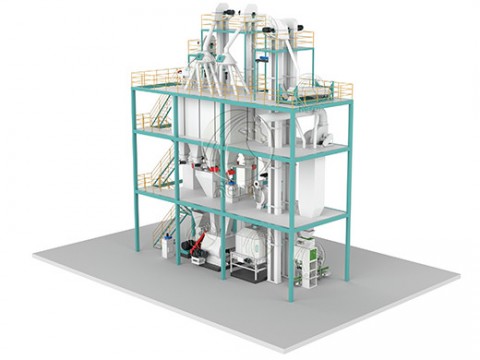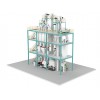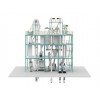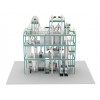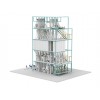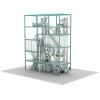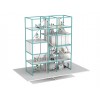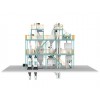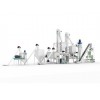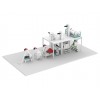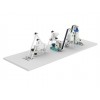What is The 8-12T/H Feed Pellet Line ?
This 8-12 t/h feed pellet line is suitable for processing various animal feeds, such as chicken feed, poultry feed, livestock feed, bird feed, duck feed, goose feed, cattle feed, sheep feed, camel feed, horse feed, pig feed, rabbit feed, fish feed, shrimp feed, crab feed, aquatic feed, etc.
The main equipment of a complete 8-12T/H feed pellet production line includes a hammer mill machine, 8-12 t/h feed pellet making machine, single shaft screw mixer, counter-flow feed pellet cooler, pellet crumbler machine, box cylinder pulse dust remover, vibrating screen classifier, bucket elevator, automatic bagging system, etc. This complete feed pellet plant can accomplish raw material mixing, transmission, feeding, and pelletizing. After the raw materials become feed pellets, the following equipment can cool them down and pack them into bags.

The animal feed pellet production line has good raw material versatility and can be used for the granulation of various raw materials such as corn, sorghum, wheat, beans, and oilseed meal. At the same time, the animal feed production plant has the characteristics of low energy consumption, high production efficiency, and large profits. It is especially suitable for large feed mills, breeding farms, large farms, etc. At the same time, we provide free installation, training, factory design, and timely after-sales service.

Some Questions about the 8-12T/H Feed Pellet Line
1. Who is suitable for this 8-12t/h feed pellet production line?
This animal feed production line is specially designed for large farmers, large animal farm plants, animal feed suppliers, etc.
2. What raw material can be used in the 8-12t/h feed pellet production line?
Animal feed pellet production line raw materials include corn/maize, wheat, grass, alfalfa, oil seed meal & cakes, pasture, bone meal, microelements, etc., and other kinds of raw materials, such as premix, vitamins, wheat bran, salt and other. Different formulations can be made according to different formulas and the needs of the animals being farmed.


3. Why Choose Our Animal Feed Production Line?
Widely Applications: This animal feed pellet mill plant can make feeds for poultry, livestock, sheep, pig, cattle, chicken, duck, fish, shrimp, crab, aquatic, and other animals, it makes pellets for 1-12mm diameter, the pellet size is can be changed with the our feed pellet machine by adjust die. It also can produce mash and crumble.
Small Investment: the compact design of this small feed mill plant can reduce the investment in workshops, etc.
Low Installation Cost: Our feed production line comes with detailed installation and commissioning instructions, it is easy to install the machine, and you can use it immediately after the machine is installed.
Low Production Cost: The animal feed factory only needs 1-2 production workers to complete the production operation. With less labor and lower production costs, your profits will increase.
4. What kind of animal feed pellet production line produce?
This feed pellet production line can produce feed for meat chicken, broilers, laying hens, small baby chicken feed, cattle feed, pig feed, duck feed, sheep feed, poultry feed, livestock feed, goat feed, etc. Such as 2-4mm diameter chick feed pellets and pig feed pellets. 2-5mm rabbit feed pellets, 4-8mm cattle or sheep feed pellets.
This feed pellet mill with a ring die, makes pellets of 1-12mm in diameter, the pellet size can be changed with our feed pellet machine by adjusting the die.
5. What we can do for you?
We can provide the project design, flow chart, feed-making machine manufacturer, the project installation and commission, your staff training, after-sales service, etc. Also, our professional install team will service you if you need it.
What is The Complete Animal Feed Pellet Production Line Working Process ?
Feed Pellets Processing Technology
Raw Material → Feed Grinding → Feed Mixing → Feed Pelletizing → Pellet Cooling → Pellet Crushing → Screening & Grading → Pellet Packing

1. Storage of the raw materials
There are many different raw materials and materials in the feed, so various types of silos must be used. There are three types of silos that can be used in the feed pellet line, such as hopper silo, flat bottom silo, and galvanized silo.
2. Cleaning of raw materials
Impurities in feed raw materials not only affect the quality of feed products but also directly affect the use of feed processing equipment and the personal safety of staff. In severe cases, the entire equipment will be damaged and the smooth progress of feed production will be affected. Therefore, impurities in the feed raw materials should be removed in time.
3. Crushing of raw materials
The technological process of feed crushing is determined according to the required particle size, feed variety, and other conditions. According to the number of raw material crushing, it can be divided into primary crushing process and circulating crushing process or secondary crushing process. The combination with the batching process, can be divided into the first batching and then crushing process and the first crushing and then batching process.
4. Batching process
The rational design of the batching process is to correctly select the specifications and quantities of the batching metering device so that it is fully coordinated with the combination of batching feeding equipment, mixing units, and other equipment.
5. Mixing process
The mixing process refers to the technological method and process of weighing the ingredients in the feed formula and then entering the mixer for uniform mixing. The mixing section requires a short mixing cycle, high mixing quality, fast discharge, low residual rate, good air tightness, and no dust spillage.
6. Pelleting process
The pelleted feed obtained by compacting and extruding a single raw material or compound mixture by mechanical action is called feed pelleting. The purpose of pelleting is to use the heat, moisture, and pressure in the pelleting process to pelletize the feed that is finely divided, easily dusty, poorly palatable, and difficult to transport.

7. Cooling process
During the pelleting process, when the pellet feed comes out of the feed pellet machine, the water content reaches 16%-18%, and the temperature is as high as 75°C-85°C. It will also cause adhesion and mildew during storage. The moisture must be reduced to below 14%, the temperature must be below 8°C higher than the air temperature, and cooling is required.
8. Crumbling process
In the production process of the feed pellet mill, in order to save electricity, increase production and improve quality, the material is often made into a certain size of pellets, and then crushed into qualified products according to the size of the feed pellets.
9. Screening process
After the pellet feed is processed by the crushing process, some unqualified materials such as powder will be produced. Therefore, the crushed pellet feed needs to be sieved into a product with neat particles and uniform size.
10. Packaging process
After weighing, put the finished product into the packing scale and pack it. During this process, the package should be calibrated until the package weight standard is met.

